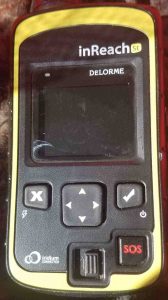Communication While Backpacking
Communicating while backpacking might seem like the last thing that you would want to do. After all, we leave technology behind to embrace the wilderness and to focus on nature. Technology can interfere with this– there’s no better feeling than being completely “off the grid” for a week, completely disconnected from the outside world. However, there are exceptions to this- you may be backpacking alone, have health problems, or have family that needs checking on. In these circumstances, communication while camping in a remote location is not only a good idea, but a need. Thankfully, there is more than just one option when it comes to backcountry communication, and the price tag on one of the options will work with almost any budget.
The first option for backpacking communication is the ever-popular Spot satellite communication device (. This device currently costs $170 for the Spot device itself, and $200/year for service. If you’re like me, the yearly rate makes the most sense (I hike and snowshoe throughout the year), but plans are also available at $20 per month. This is the first downside- both the service and the device are expensive, which will automatically exclude hikers on a budget. The second downside is that a local search and rescue team may not immediately respond to a distress call from a Spot device as an emergency.
Spot devices do not have the ability to send an in-the-moment custom message, they only communicate your GPS coordinates to search and rescue teams. False alarms and abuse of the system in the past has left search and rescue teams with a distrust of the accuracy of the system. This isn’t just limited to the Spot device- forest rangers and search and rescue teams have responded to numerous false alarms where hikers have either accidentally pressed the emergency button on their satellite messaging device, or they pressed it under frivolous circumstances. Don’t take my word for it, there are many examples of abuse:
https://www.wildsnow.com/2323/plb-rescue-beacon-acr/
https://www.sierraclub.org/sierra/2015-4-july-august/feature/danger-life-saving-device
https://www.outsideonline.com/1908371/panic-button
Another disadvantage of these devices is that with the press of a single button, help will be summoned. It might not be needed, and it might waste precious resources to find a hiker that is perfectly safe. It also might add confusion- rescuers might not be able to understand exactly where you are, even with GPS coordinates. An alternative and popular product, Garmin’s inReach Explorer, attempts to solve some of those problems. Featuring the ability to send messages back and forth, Garmin’s products allow you to send more information than just, “Help!”. With this, the false alarm potential goes out the window, leaving you with one problem- the price tag. The Garmin inReach Explorer currently sells for $450, and a less expensive model with similar features retails for $400; both of these also require a subscription of $12-$24 per month. That being said, both the Spot and Garmin’s inReach Explorer offer one thing that most don’t– an almost guaranteed way to contact help.
Either satellite-based service has a huge advantage in that most of the globe is covered- if you’re backpacking in Alaska, kayaking in Oregon, camping in the Everglades, or climbing Machu Picchu, you’ll get service. This is no small feat- satellites are expensive, and the fees associated with these devices reflect this. If you want the most reliable way to contact the outside world, these devices are the best solutions available. If your needs are a little more forgiving, there is another option- Amateur Radio.
Amateur radio, or ham radio, has been used for rescue operations for decades. It’s cheap, reliable, and effective. However, there are two major drawbacks to ham radio. The first major drawback is that you need an amateur radio license in order to transmit anything over ham radio frequencies. There is an exception for emergency traffic (which does not require a license), but ham radio has enough of a learning curve that you will want to be intimately familiar with your equipment before you start your backpacking adventure. The other drawback for ham radio is the reception.
To make a long story short, inexpensive ham radios may not work well in the area that you’re exploring. Without spending upwards of $600, your transmission range will be limited to approximately 50 miles. There are ways to overcome this, and I’ve written a separate article about Hiking with Ham Radio, which discusses those ways. Despite these two disadvantages, there is a huge advantage to using a ham radio: it’s cheap and fun for those of us that enjoy “tinkering” with technology.
A good handheld radio, extra antenna, and an optional TNC module (allows you to send messages to your family, see the above article if you’re interested) will only cost $140-$180. If you leave the TNC module out, you’re looking at $75 for a way to get help in an emergency. You will also need to pass a test (which is easy for technician class), and testing fees are typically $20. Now, let’s discuss the issue of reliability.
Assuming that you purchase a handheld radio, and higher gain antenna for it, your reception should be good in most circumstances. You will need to research local frequencies before your trip if you are visiting an area you typically don’t visit, but usually you can expect to be able to communicate 50 miles, although mountainous terrain can limit this reception. There are ways to increase your range (read Hiking with Ham Radio), and if you spend significantly more, you can increase your transmitting range to hundreds of miles. However, weather and solar conditions can impact the ability for you to use your radio, and geological features can render radio operation impossible. Ham radio has nowhere near the reliability of satellite-based systems, but it does carry a price tag that most can afford.
The major differences between these two types of communication are cost and reliability. If you can afford one of Garmin’s solutions, it is currently the most effective backcountry communication system. If you’re like me, and simply can’t afford the price tag on these systems, check out ham radio. It’s the best “bang for your buck”, but it does require work on your part to learn the radio, and it isn’t nearly as reliable as a satellite-based system. In the end, if you want peace of mind while backpacking, either one of these systems will work. You will need to decide whether a semi-reliable and cheap system fits your needs, or if you need the best system that money can buy. No one can make that decision for you, and I won’t judge you either way. In the end, it’s your family, your safety, and your life on the line– only you can decide which system is best for you.

